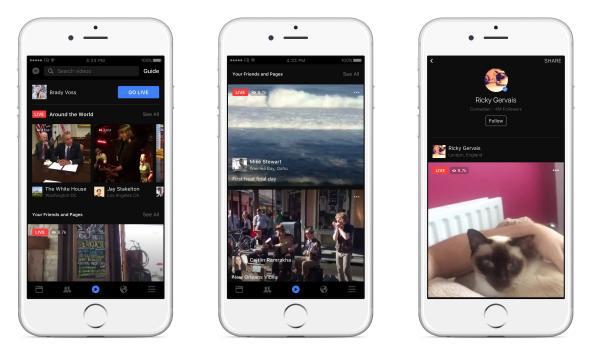Mark Zuckerberg is on record as being “obsessed” with live video on Facebook. He views it as the next step in the social network’s evolution. On Wednesday, the company backed up his words with a major update that gives live videos prime placement in the Facebook app and adds new ways to find, create, share, and react to them. The move effectively makes live video a central feature of the social network.
On iOS and Android devices, a play-button icon for live video replaces the Facebook Messenger icon on the app’s home screen. Tap on it, and you’ll be taken to a hub that lets you see which of your friends is broadcasting live, view popular live broadcasts from around the world, or tap a button to go live yourself.
On Facebook.com, you can now view a live map of broadcasts taking place around the world. And you can now broadcast live to specific audiences, such as those in a Facebook group or those invited to an event, rather than to the public at large. Those watching a live video can send reaction emojis in real time, rather than just liking the video as a whole. When you watch a replay, you’ll see the reaction emojis pop up on the screen at the same point in the video when people sent them. You can also invite friends to join you in watching a live video and they’ll get a push notification linking to the feed. Live, live, live!
It’s not hard to see what appeals to Zuckerberg and co. about live video. It offers a fresh way to interact on a platform that can feel so familiar that it risks feeling stale. Broadcasting live to your friends, or even just watching a friend’s live broadcast, can feel exciting and even a little dangerous. That’s exactly the type of feeling that Facebook itself once evoked and that upstarts like Snapchat have managed to capture in recent years.
Talking with BuzzFeed’s Mat Honan about the company’s big push into live video, Zuckerberg used the phrase “raw and visceral” in two separate quotes, and threw in a third “raw” for good measure. (Re/code’s Kurt Wagner reported, and BuzzFeed subsequently disclosed, that Facebook is actually paying BuzzFeed and a few other news publishers to produce their own live videos in order to help the platform take off. Mat Honan, the BuzzFeed editor who wrote the piece, told me on Twitter that he did not learn of the arrangement until after his story was published.)
However you describe it, the approach seems to be resonating: On average, Facebook says people are commenting 10 times more on live videos than they do on regular videos.

Facebook is not alone in viewing live video as the hot new trend in social media. The current revival of the old webcam trend can be traced roughly to the initial viral success of an Israeli live-streaming startup called Meerkat, which took the South by Southwest Interactive conference by storm in March 2015. It was soon eclipsed by Periscope, a similar service that Twitter had quietly acquired a few months earlier, and which it loudly launched just as Meerkat was gaining steam. Another new service, called Blab, puts the Periscope concept in a group-chat setting. And Twitter just this week struck a deal with the NFL to stream Thursday-night football games. Sources told me Twitter beat out Facebook, among others, for those rights.
“We’re entering this new golden age of video,” Zuckerberg told BuzzFeed. “I wouldn’t be surprised if you fast-forward five years and most of the content that people see on Facebook and are sharing on a day-to-day basis is video.”
Well, I would.
As a strategic move, investing in live video makes sense for Facebook and its rivals. If it proves to be a mainstream hit, they will have gotten in on the ground floor. And if the craze peters out, they’ll still have their core service to fall back on.
But just because big tech companies are throwing millions of dollars and hundreds of engineers at a trend doesn’t necessarily mean it will catch on with the masses. (Never forget Woo Woo.) Social live video seems like a particularly strong candidate to be viewed in retrospect as a fad—or, more likely, a niche medium that appeals to some public figures and publishers and their audiences without ever revolutionizing how ordinary individuals communicate with one another.
Services like Skype, FaceTime, Google Hangouts, Livestream, and Ustream have offered live video for years, and they certainly have their place—particularly when it comes to connecting with distant friends and family members. But that place is not at the top of a Facebook feed, which lends itself more to casual browsing than face-to-face interaction.
Zuckerberg told BuzzFeed’s Honan that the rawness of live video, paradoxically, lowers the social barriers to producing it. (No doubt he has in the back of his mind the comfort that Snapchat users have developed with snapping and sharing their own videos and selfies.) “Because it’s live, there is no way it can be curated,” he said. “And because of that it frees people up to be themselves.”
He may be underestimating the extent to which Snapchat’s success depended on its not being Facebook—that is, if you’re a young person, it’s a place where your parents, teachers, and bosses are unlikely to find you. At the same time, I think Zuckerberg is overestimating the proportion of the public that wants to share live video with more than a few close friends at a time. (I’d guess it’s a subset of the 20 percent or so who feel comfortable tweeting on Twitter.) Going live on Facebook, even with the ability to target members of a specific group or event, still feels like broadcasting; Snapchatting is more like narrowcasting.
That said, Facebook has a lot of power in the social media marketplace, and we should all expect to see and hear a lot about live video in the coming months. If nothing else, celebrities, publishers, and others who depend on publicity—Slate and myself included—are likely to give it a try in hopes of tapping into the vast audience that Facebook seems able to summon at will with a few tweaks of its mighty algorithm.
Previously in Slate:
